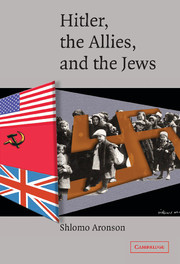Book contents
- Frontmatter
- Contents
- Preface
- Acknowledgments
- List of Abbreviations
- PART I THE MAKING OF THE MULTIPLE TRAP
- PART II THE RESCUE DEBATE, THE MACRO PICTURE, AND THE INTELLIGENCE SERVICES
- PART III THE SELF-DEFEATING MECHANISM OF THE RESCUE EFFORTS
- 18 Istanbul, Geneva, and Jerusalem
- 19 How the Holocaust in Slovakia Was Suspended: The “Europa Plan”
- 20 The Significance of the British Decrypts
- 21 The “Small Season”: Begin's Rebellion
- 22 The Origins of the Budapest “Rescue Committee”
- 23 The War Refugee Board and the Extension of the Trap: The “Dogwood” Chain
- 24 The Double Hungarian Debacle
- PART IV THE BRAND–GROSZ MISSIONS WITHIN THE LARGER PICTURE OF THE WAR AND THEIR RAMIFICATIONS
- PART V THE END OF THE FINAL SOLUTION: BACK TO HOSTAGE-TAKING TACTICS
- Epilogue: Self-Traps: The OSS and Kasztner at Nuremberg
- Notes on Sources
- Selected Bibliography
- Index
23 - The War Refugee Board and the Extension of the Trap: The “Dogwood” Chain
Published online by Cambridge University Press: 22 July 2009
- Frontmatter
- Contents
- Preface
- Acknowledgments
- List of Abbreviations
- PART I THE MAKING OF THE MULTIPLE TRAP
- PART II THE RESCUE DEBATE, THE MACRO PICTURE, AND THE INTELLIGENCE SERVICES
- PART III THE SELF-DEFEATING MECHANISM OF THE RESCUE EFFORTS
- 18 Istanbul, Geneva, and Jerusalem
- 19 How the Holocaust in Slovakia Was Suspended: The “Europa Plan”
- 20 The Significance of the British Decrypts
- 21 The “Small Season”: Begin's Rebellion
- 22 The Origins of the Budapest “Rescue Committee”
- 23 The War Refugee Board and the Extension of the Trap: The “Dogwood” Chain
- 24 The Double Hungarian Debacle
- PART IV THE BRAND–GROSZ MISSIONS WITHIN THE LARGER PICTURE OF THE WAR AND THEIR RAMIFICATIONS
- PART V THE END OF THE FINAL SOLUTION: BACK TO HOSTAGE-TAKING TACTICS
- Epilogue: Self-Traps: The OSS and Kasztner at Nuremberg
- Notes on Sources
- Selected Bibliography
- Index
Summary
Much has been written about the origins of the War Refugee Board (WRB) and its official creation in January 1944. The present writer has first one important document to add to the published literature, found in the papers of Undersecretary of State Edward R. Stettinius, Jr., dated January 7, 1944, and already partially quoted earlier, which carried the heading “Summary of Recommendations for Specific Action”:
Release of Persons from Axis Europe (underlined in original)
1. The President or the Department [of State] should enter into negotiations with Hitler or the German Government, through the Pope or through the heads of the Governments of Switzerland or Sweden, to reach an understanding which would permit the release of Jews at a certain rate per month consistent with the capacity of available neutral shipping and of Spanish and Turkish railroads. If initial negotiations on humanitarian grounds fail, consideration should be given to further appeals offering a quid pro quo to the Germans such as hope of less severe peace terms or the possibility of reduced bombing of certain cities or areas.
Next to this first paragraph and underneath, a single handwritten word was added: “No.” We do not know whether the document was a summary of Jewish demands made possibly by Peter Bergson, alias Hillel Kook, of the IZL Mission in the United States and communicated to Stettinius by Assistant Secretary Long, to be rejected by both or by a higher authority, or by another State Department official, as it seemed to have given Hitler what he might have wanted to achieve among other things during the Final Solution: a sense of emergency among the Western Allies, as influenced by the Jews as they supposedly were to do it, to make concessions to him if they wanted Jews to be saved from his mills of death, or to supply him with official evidence that the war was about Jews.
- Type
- Chapter
- Information
- Hitler, the Allies, and the Jews , pp. 197 - 213Publisher: Cambridge University PressPrint publication year: 2004



